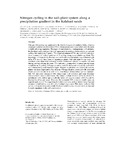Nitrogen cycling in the soil–plant system along a precipitation gradient in the Kalahari sands
Date
2004-01-01Author
Aranibar, J.N.
Otter, L.
Macko, S.A.
Feral, C.J.W.
Epstein, H.E.
Dowty, P.R.
Eckardt, F.
Shugart, H.H.
Swap, R.J.
Publisher
Blackwell PublishingType
Published ArticleMetadata
Show full item recordAbstract
Nitrogen (N) cycling was analyzed in the Kalahari region of southern Africa, where a
strong precipitation gradient (from 978 to 230mm mean annual precipitation) is the main
variable affecting vegetation. The region is underlain by a homogeneous soil substrate,
the Kalahari sands, and provides the opportunity to analyze climate effects on nutrient
cycling. Soil and plant N pools, 15N natural abundance (d15N), and soil NO emissions
were measured to indicate patterns of N cycling along a precipitation gradient. The
importance of biogenic N2 fixation associated with vascular plants was estimated with
foliar d15N and the basal area of leguminous plants. Soil and plant N was more 15N
enriched in arid than in humid areas, and the relation was steeper in samples collected
during wet than during dry years. This indicates a strong effect of annual precipitation
variability on N cycling. Soil organic carbon and C/N decreased with aridity, and soil N
was influenced by plant functional types. Biogenic N2 fixation associated with vascular
plants was more important in humid areas. Nitrogen fixation associated with trees and
shrubs was almost absent in arid areas, even though Mimosoideae species dominate.
Soil NO emissions increased with temperature and moisture and were therefore
estimated to be lower in drier areas. The isotopic pattern observed in the Kalahari (15N
enrichment with aridity) agrees with the lower soil organic matter, soil C/N, and N2
fixation found in arid areas. However, the estimated NO emissions would cause an
opposite pattern in d15N, suggesting that other processes, such as internal recycling and
ammonia volatilization, may also affect isotopic signatures. This study indicates that
spatial, and mainly temporal, variability of precipitation play a key role on N cycling and
isotopic signatures in the soil–plant system.

